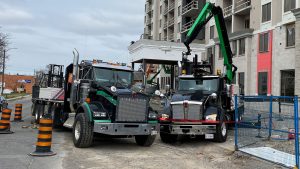When it comes to finishing flat seams on walls and ceilings, achieving the correct mud consistency for your flat box is crucial. The goal? Smooth coverage, minimal shrinkage, and minimal effort, so your team can work faster and smarter.
Mud Mixing Guidelines
When it comes to mud consistency, it often comes down to personal preference. However, it’s good to know where to start. Add your box of mud to a 5-gallon bucket with about 28oz to 30oz of water and mix thoroughly. Continue adding water to your mix until it reaches your preferred consistency. Aim for a consistency that’s fluid enough to dispense easily but thick enough to maintain body and control.
Why Consistency Matters
Thinner mud is lighter and will flow more easily through the flat box. If it’s too thin, it will flow out too quickly, drip, leave drag marks at the start of a run, and have more shrinkage as it dries. On the other hand, thicker mud will result in a smoother finish, but will require more physical effort to dispense evenly. If you have to push hard to fill the joints, the mud consistency is too thick.
Tip: A flat box on a fully extended handle can make the job easier for high ceilings.
The Best Type of Mud for Flat Boxes
Avoid setting compounds that have a specific dry time. Cleaning your tools can become a nightmare if you don’t do it before the mud sets. Instead, use standard or lightweight general-purpose mud for professional results and easier cleanup. While this means more drying time, the efficiency of automatic flat boxes can compensate for the lost time.
Matching the mud consistency to your tool and material conditions is a science. Test small batches, observe results, and refine adjustments by site conditions. With the right mud consistency, you’ll be rewarded with faster application, a cleaner finish and fewer coats with less sanding. Visit Clare Interiors for more expert drywall tips and professional tools of the trade.

